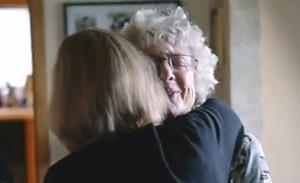Life-Affirming: Showtime's 'Time of Death'
Milton Berle’s Private Joke File, all 642 pages of it, has lots more to say about dentists than death. For that matter, even parrots get more ink.
Death, after all, is no laugh riot, although Berle gave it a shot with this one-liner: “I looked at the obituaries the other day and I realized something -- everybody dies in alphabetical order!”
Showtime’s Time of Death documentary series, premiering Friday, Nov. 1, at 9 p.m. ET, perhaps is best served with a punch line before this review gets underway. Friday night escapism it’s not, which Showtime entertainment president David Nevins fully realizes. In his note accompanying the review DVDs, Nevins says in part: “It is not the easiest show to watch, but I’ve always wanted to explore the subject in detail. Death is the most universal topic there is, and yet its examination is largely taboo in our culture.”
There are six weekly episodes in all, with 48-year-old Maria Lencioni’s story spotlighted in all of them while other subjects near death play what amount to major supporting parts. I’ve watched the first two, and came away teary-eyed each time. This is a powerfully affecting series, and an enduring memorial to otherwise ordinary people whose last days ended up being anything but camera shy.
Maria, who lives on a farm in Santa Cruz, CA, is the divorced mother of three children: 25-year-old Nicole (also called “Little”), 15-year-old Julia and 14-year-old Andrew. She has terminal Stage 4 breast cancer and so far has been more willing to talk about this with the filmmakers than with her offspring.
“They shouldn’t be faced with all this cockadoodle,” Maria says in Episode 2.
Nicole, heavily tattooed and long at odds with her mother, has moved back to Santa Cruz with the goal of gaining custody of her two siblings. Neither wants to live with their biological father, who allegedly was “abusive.” He’s unseen in the first two episodes, but will make a “surprise visit” in Hour 4, according to publicity materials.
The turbulent family dynamics of the Lencionis are raw and interesting to a point. But Time of Death gets much of its punch and immediacy from the up-close looks at those whose lives will span just a single episode.
Friday’s premiere introduces Michael John Muth, a 47-year-old Navy veteran in the final stages of a rare cancer called rhabdomyosarcoma. Living his last days in a hospice, he’s also a veteran of two divorces (“I was the bad guy in both marriages; let’s put it that way”), with an early history of drug abuse.
Nonetheless, his father is steadfastly by his side, as is Michael’s stepmother. “I profusely apologize to this man for all the shit I put him through growin’ up,” Michael says.

“We live in a death-denying culture, and I don’t want it to be that way,” she says. “I want my life to have made some difference.”
She and Lenore’s husband, Mel, were divorced for a brief period before remarrying and spending 53 years of their lives together. They have two sons, but lost a third to a teenage drowning death.
By the time of her 75th birthday, Lenore was too weak to get out of bed. But she wanted the family to celebrate anyway. And so they do, before everyone joins her for a birthday video of past milestones together. I’m getting misty just writing about it.
Time of Death tells its stories without appearing to be voyeuristic or intrusive. Lenore didn’t want cameras present for her final minutes, and so the filmmakers step aside. It would have been quite something, though, with Mel later relating that his wife looked fondly at him and said twice, “It was terrific.”
In a culture awash in share-it-all “social media” and seemingly all-seeing phone cams, most of us likely would still prefer to die in private. Time of Death breathes new life into a handful who chose otherwise. And with this series, they also chose pretty wisely.